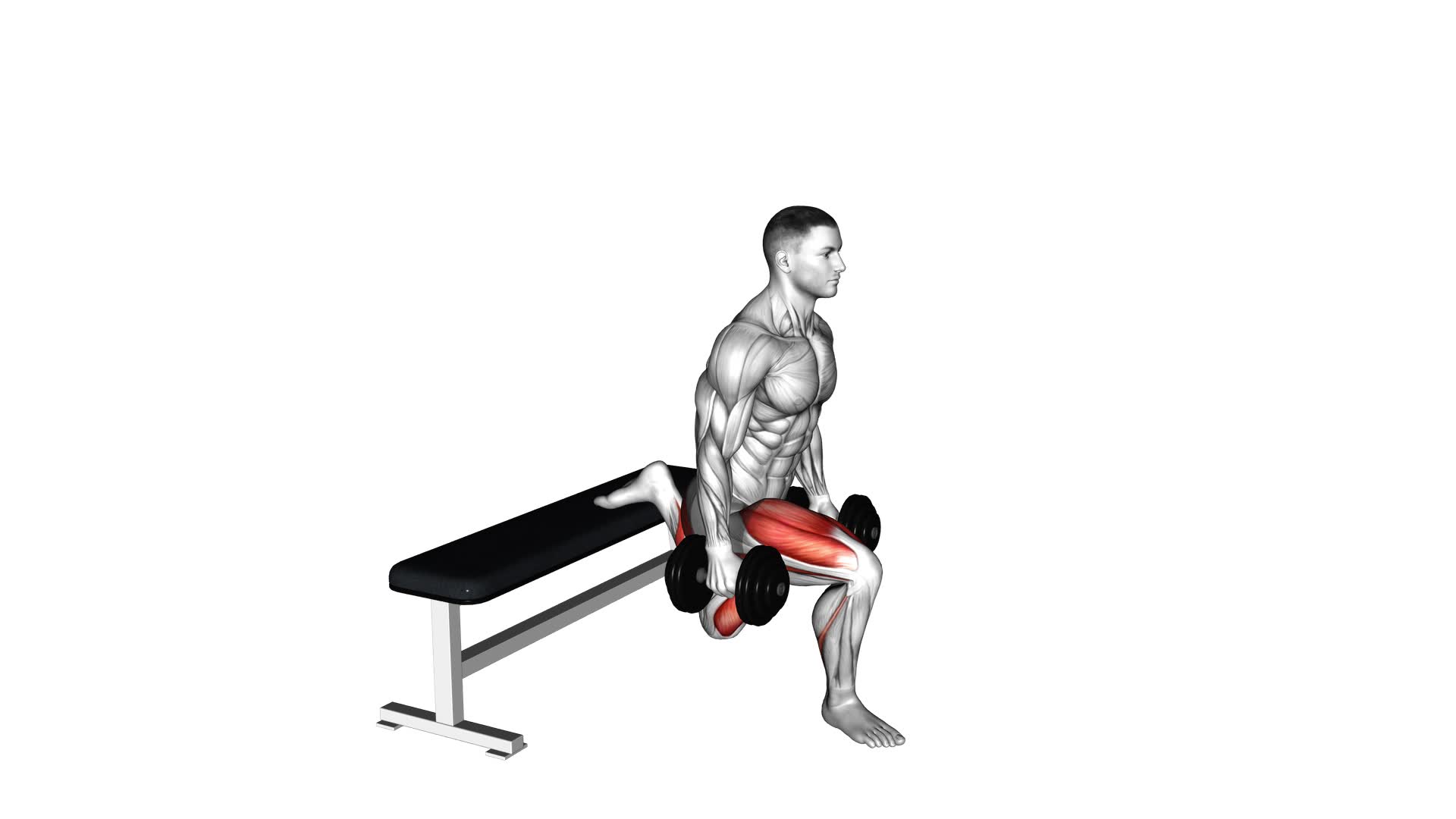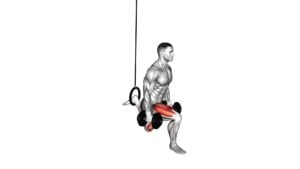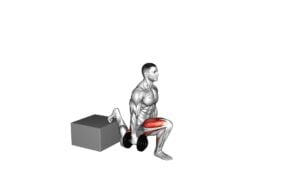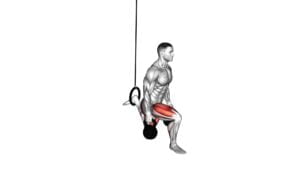Dumbbell Single Leg Split Squat – Video Exercise Guide & Tips

Get ready to sculpt and strengthen your lower body with the Dumbbell Single Leg Split Squat.
Watch This Exercise Video
In this video exercise guide, you'll learn the proper form and techniques for this challenging exercise.
With variations and progressions, you can customize your workout to suit your fitness level.
Avoid common mistakes and get the most out of your workout with helpful tips.
Let's dive in and take your leg day to the next level with the Dumbbell Single Leg Split Squat.
Key Takeaways
- The dumbbell single leg split squat improves balance and stability.
- It targets the quadriceps, hamstrings, and glutes.
- It engages core muscles for balance.
- Proper form and technique are essential for maximum benefits.
Benefits of the Dumbbell Single Leg Split Squat
One benefit of the Dumbbell Single Leg Split Squat is that it helps you improve your balance and stability. This exercise is a modification of the traditional split squat, where you hold dumbbells in each hand to add resistance. By performing the exercise on one leg at a time, you engage your core muscles to maintain balance and stability throughout the movement.
The Dumbbell Single Leg Split Squat primarily targets the quadriceps, hamstrings, and glutes. The quadriceps, located in the front of your thighs, are responsible for extending your knee. The hamstrings, located in the back of your thighs, help flex your knee and extend your hip. The glutes, which include the gluteus maximus and gluteus medius, are the muscles responsible for hip extension and abduction.
In addition to these primary muscle groups, the Dumbbell Single Leg Split Squat also engages your calf muscles, hip flexors, and stabilizing muscles in your feet and ankles. By working these muscles, you can improve your overall leg strength and stability, which can translate into better performance in other exercises and activities.
Proper Form and Technique for the Dumbbell Single Leg Split Squat
To perform the Dumbbell Single Leg Split Squat with proper form and technique, you need to ensure stability and engage the correct muscle groups. This exercise is excellent for improving balance and targeting specific muscle groups in your lower body. Here's how to do it correctly:
- Stand with your feet hip-width apart and hold a dumbbell in each hand by your sides.
- Take a big step forward with one foot and extend it out in front of you.
- Bend your knees and lower your body down towards the ground, keeping your back straight and your chest up.
- As you lower down, focus on keeping your weight on your front heel and your back knee slightly off the ground.
- Push through your front heel to return to the starting position.
- Repeat the exercise on the opposite leg.
Remember to keep your core engaged throughout the movement and maintain a controlled pace. By following these guidelines, you'll ensure that you're performing the Dumbbell Single Leg Split Squat correctly and effectively.
Now, let's move on to the next section where we'll discuss variations and progressions for the dumbbell single leg split squat.
Variations and Progressions for the Dumbbell Single Leg Split Squat
Now let's explore different ways to challenge yourself and progress with the Dumbbell Single Leg Split Squat. Here are some variations and advanced modifications you can try to take your workout to the next level:
- Barbell Single Leg Split Squat: Instead of using dumbbells, you can use a barbell to increase the resistance and intensity of the exercise.
- Weighted Vest Single Leg Split Squat: Adding a weighted vest can provide an extra challenge and make the exercise more difficult.
- Bulgarian Split Squat: This variation involves elevating the back foot on a bench or step, which increases the range of motion and targets the glutes and hamstrings even more.
- Plyometric Single Leg Split Squat: To add an explosive element to the exercise, you can perform plyometric jumps between each rep, focusing on jumping as high as possible.
- Single Leg Split Squat with Resistance Bands: Incorporating resistance bands can create a different type of resistance and challenge your muscles in a unique way.
These different equipment options and advanced modifications can help you continue to progress and challenge yourself as you become stronger and more comfortable with the Dumbbell Single Leg Split Squat. Remember to always maintain proper form and technique to prevent injury and maximize the effectiveness of your workout.
Common Mistakes to Avoid During the Dumbbell Single Leg Split Squat
When performing the Dumbbell Single Leg Split Squat, it's important to be aware of common mistakes that should be avoided. Proper form is crucial to maximize the effectiveness of this exercise while minimizing the risk of injury.
One common mistake isn't maintaining proper alignment of the front knee. It's important to ensure that the knee doesn't extend past the toes, as this can put excessive strain on the knee joint.
Another mistake to avoid isn't keeping the back straight. It's important to engage the core muscles and keep the spine in a neutral position throughout the exercise. This helps to maintain stability and prevent lower back pain.
Additionally, not fully engaging the glutes and quadriceps can also be a mistake. To get the most out of the exercise, focus on squeezing the glutes and pushing through the front heel to activate the leg muscles.
Lastly, rushing through the exercise or using momentum can compromise proper form. Take your time and perform the exercise with control and stability.
Tips for Getting the Most Out of the Dumbbell Single Leg Split Squat
To maximize your results from the Dumbbell Single Leg Split Squat, try incorporating these tips into your workout routine:
- Start with proper form: Stand upright with your feet shoulder-width apart, holding a dumbbell in each hand. Step one foot forward into a lunge position, making sure your knee is directly above your ankle and your back knee is hovering just above the ground.
- Focus on balance: Engage your core and keep your body centered as you perform the exercise. This will help improve your balance and stability.
- Use appropriate weights: Choose dumbbells that challenge you but still allow you to maintain proper form throughout the exercise. Gradually increase the weight as your strength improves.
- Control your movement: Slowly lower your body into the lunge position and then push back up using your front leg. This controlled movement will target your lower body muscles more effectively.
- Incorporate variations: Once you have mastered the basic Dumbbell Single Leg Split Squat, try adding different variations to your routine. This will help keep your workouts challenging and prevent plateaus.
By following these tips, you can improve your balance and increase lower body strength with the Dumbbell Single Leg Split Squat. Remember to listen to your body and adjust the intensity as needed.
Happy exercising!
Frequently Asked Questions
How Many Sets and Repetitions Should I Do for the Dumbbell Single Leg Split Squat?
To determine the number of sets and repetitions for the dumbbell single leg split squat, consider the benefits of adding dumbbells to this exercise. Adding resistance can increase muscle strength and improve overall stability. However, it's important to listen to your body and make modifications if you have knee or hip issues.
Start with 2-3 sets of 8-12 repetitions, and gradually increase as you become stronger and more comfortable with the exercise. Always consult with a fitness professional for personalized guidance.
Can I Perform the Dumbbell Single Leg Split Squat With Bodyweight Only?
Yes, you can modify the dumbbell single leg split squat for beginners by performing it with just your bodyweight. This exercise is an effective way to strengthen your lower body. It targets your quadriceps, glutes, and hamstrings, helping to improve balance and stability.
Is the Dumbbell Single Leg Split Squat Suitable for Beginners?
The dumbbell single leg split squat is a great exercise for beginners looking to improve their lower body strength and stability. It targets the quads, glutes, and hamstrings.
To perform it, keep your chest up, back straight, and lower your back knee towards the ground.
Common mistakes include leaning forward or allowing the front knee to extend past the toes.
To increase difficulty, add dumbbells or progress to a Bulgarian split squat.
Can I Use a Smith Machine for the Dumbbell Single Leg Split Squat?
Using a Smith machine for split squats can be a good alternative if you don't have access to dumbbells. It provides stability and support, which can be helpful for beginners. However, keep in mind that the Smith machine limits your range of motion and may not engage your stabilizing muscles as much as dumbbells would.
The dumbbell single leg split squat has the advantage of working your legs unilaterally, improving balance and strength.
Should I Perform the Dumbbell Single Leg Split Squat Before or After Other Leg Exercises in My Workout Routine?
You should perform the dumbbell single leg split squat before other leg exercises in your workout routine.
This exercise targets your quads, glutes, and hamstrings, helping to build strength and stability in your lower body.
By doing it first, you can fully activate these muscles and ensure proper form.
Advanced trainers can modify the exercise by using heavier dumbbells or adding a jump at the top for an extra challenge.
Conclusion
In conclusion, the dumbbell single leg split squat is a highly effective exercise that targets the lower body muscles while improving balance and stability. By maintaining proper form and technique, you can maximize the benefits of this exercise.
There are also variations and progressions available to challenge yourself as you get stronger. Avoid common mistakes and follow the tips provided to ensure you get the most out of your workouts.
Incorporate the dumbbell single leg split squat into your routine for a stronger lower body.

Author
Years ago, the spark of my life’s passion ignited in my mind the moment I stepped into the local gym for the first time. The inaugural bead of perspiration, the initial endeavor, the very first surge of endorphins, and a sense of pride that washed over me post-workout marked the beginning of my deep-seated interest in strength sports, fitness, and sports nutrition. This very curiosity blossomed rapidly into a profound fascination, propelling me to earn a Master’s degree in Physical Education from the Academy of Physical Education in Krakow, followed by a Sports Manager diploma from the Jagiellonian University. My journey of growth led me to gain more specialized qualifications, such as being a certified personal trainer with a focus on sports dietetics, a lifeguard, and an instructor for wellness and corrective gymnastics. Theoretical knowledge paired seamlessly with practical experience, reinforcing my belief that the transformation of individuals under my guidance was also a reflection of my personal growth. This belief holds true even today. Each day, I strive to push the boundaries and explore new realms. These realms gently elevate me to greater heights. The unique combination of passion for my field and the continuous quest for growth fuels my drive to break new ground.







